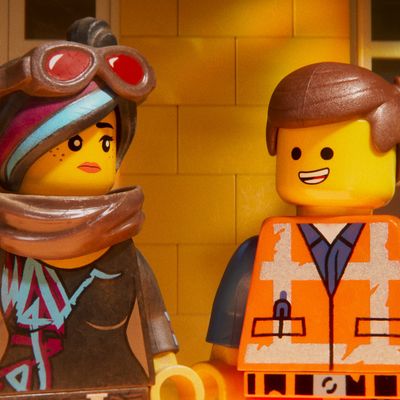
For us adults, anyway, it’s hard to believe it’s been five years since the first Lego Movie. Phil Lord and Christopher Miller’s irreverent animated film defied nearly every expectation for what a film about a brand of Scandinavian building blocks could be, and it had a message rebellious enough to make you forget you were watching a highly competent piece of corporate content strategy. But five years is a lifetime in kid years, and the first proper sequel (after the success of the Lego Batman spinoff and disappointment of the Lego Ninjago spinoff) will meet young fans of the original at a time when they feel significantly more grown-up than the little kid they were when they first met Emmet and friends. The sequel grows up with them as well — even the eternal earworm “Everything Is Awesome” is met with its down-tempo 2019 rejoinder: “Everything’s Not Awesome.”
And nothing is terribly awesome in Bricksburg as the film opens; “grimdark” would perhaps be a better descriptor. Following the invasion of the Duplo bricks at the tail end of the first Lego Movie, Bricksburg has become a desolate shell of itself, redubbed “Apocalypseburg,” where “Wyldstyle” Lucy (Elizabeth Banks) can brood and wear goggles to her gritty heart’s content, the star of her very own Mad Max spinoff. Emmet (Chris Pratt), meanwhile, has remained unchanged by the hard times, and eagerly awaits the end of the instability that Lucy so relishes. But Bricksburg is no longer hospitable to such naïveté, and the pressure to be “tougher” in these meaner and leaner times dogs Emmet and Lucy’s relationship. Then the Duplos invade again and Lucy is abducted, along with Batman (Will Arnett), Benny the Astronaut (Charlie Day), MetalBeard (Nick Offerman), and Princess Unikitty (Alison Brie) to the dreaded SyStar System.
The SyStar System is in fact the sparkly domain of Bianca (The Florida Project’s Brooklynn Prince), little “SyStar” of human boy Finn (Jadon Sand). And accordingly, Apocalypseburg is just a manifestation Finn’s adolescent angst, rendered as a plastic landscape. Finn, the child who drove the action in the original film, is now a preteen who prefers to turn his basement Lego workshop into a dusty wasteland rather than a colorful metropolis, and Bianca just wants to follow in his footsteps. The brilliance of Lord and Miller’s film is the way in which, even more so than in its predecessor, the meta story informs the mini-figures’ story — the strings of Emmet and company’s galaxy-hopping adventure are being pulled by a very human-scale spat between brother and sister. The threat of “Our-mom-ageddon” looms over characters on both sides of the conflict; if a fight breaks out, “our mom” (Maya Rudolph, taking over parental duties from a voice-only Will Ferrell) will put all the bricks in eternal storage — as close to the end times as the little plastic people can wrap their minds around.
The kidnapped party soon find themselves in the clutches of the shape-shifting Queen Watevra Wa’Nabi (Tiffany Haddish), a kind of embodiment of dreaded feminine chaos who just wants to make Batman her husband (certainly joining a long line of idiosyncratic cinematic women who could identify). Lucy resists the siren song of the SyStar System and its queen (there’s a literal song, and it’s called “This Song’s Gonna Get Stuck Inside Your Head,” and it is gonna) but the rest of the Bricksburg gang finds that life isn’t so bad in Bianca’s friendly, plastic world. Meanwhile, Emmet sets off on a rescue mission to save Lucy, and is helped by the Kurt Russell–esque tough guy Rex Dangervest, whose spaceship is crewed by dinosaurs and who is the embodiment of everything he thinks Lucy wants him to be.
The push-pull in the first Lego Movie was one of creativity versus following the rules, for which the titular product was a natural metaphor. This second film, like so many children’s films, is about growing up, but it’s more about dispelling a kind of forced idea of maturity. Finn, we can sense, is becoming as dogmatic about “the best way” to Lego as his father was — his values are just more aesthetic than technical — and Bianca’s mixed-media, freewheeling approach is not only more traditionally feminine (the more anthropomorphic Lego Friends line is used heavily in the SyStar System, along with those chunky Duplos) but also less coherent. She’s just a kid who wants to have fun and build a giant wedding cake, the antithesis of the cynicism of Apocalypseburg.
But ironically, The Lego Movie 2 itself is more cynical. The script is breathlessly stuffed with self-aware jokes about plot tropes and Hollywood conventions, aimed more at the adults in the room than the kids, all with the intended goal of getting knowing laughs. (At least it appears that someone on the staff read up on Trinity Syndrome between films.) BoJack Horseman creator Raphael-Bob Waksberg is listed in the writing credits, and that self-aware-within-an-inch-of-its-own-life quality looks better on the depressed horse show than in the blithely absurd stop-motion-esque world of the Lego movies. The childlike, free-associative playfulness is now underscored by a palpable hunger to be the cleverest and coolest kids’ movie on the block, a hunger that weighs down Lord and Miller’s plenty-smart silliness. Finn’s Apocalypseburg may be defanged by the film’s end, but the desire to look tough takes on many forms.

